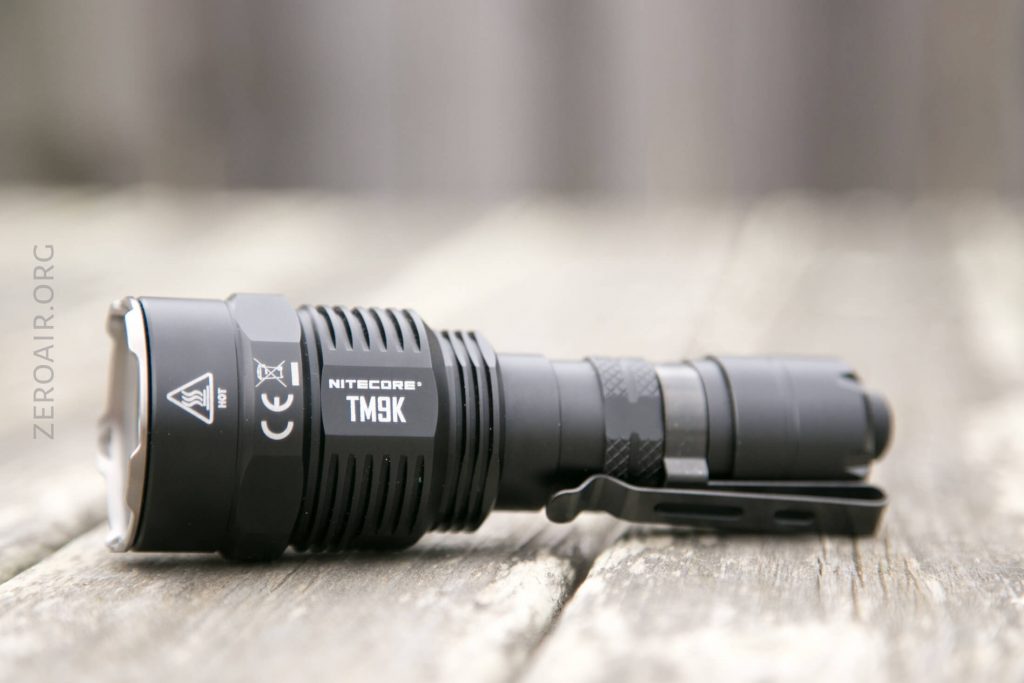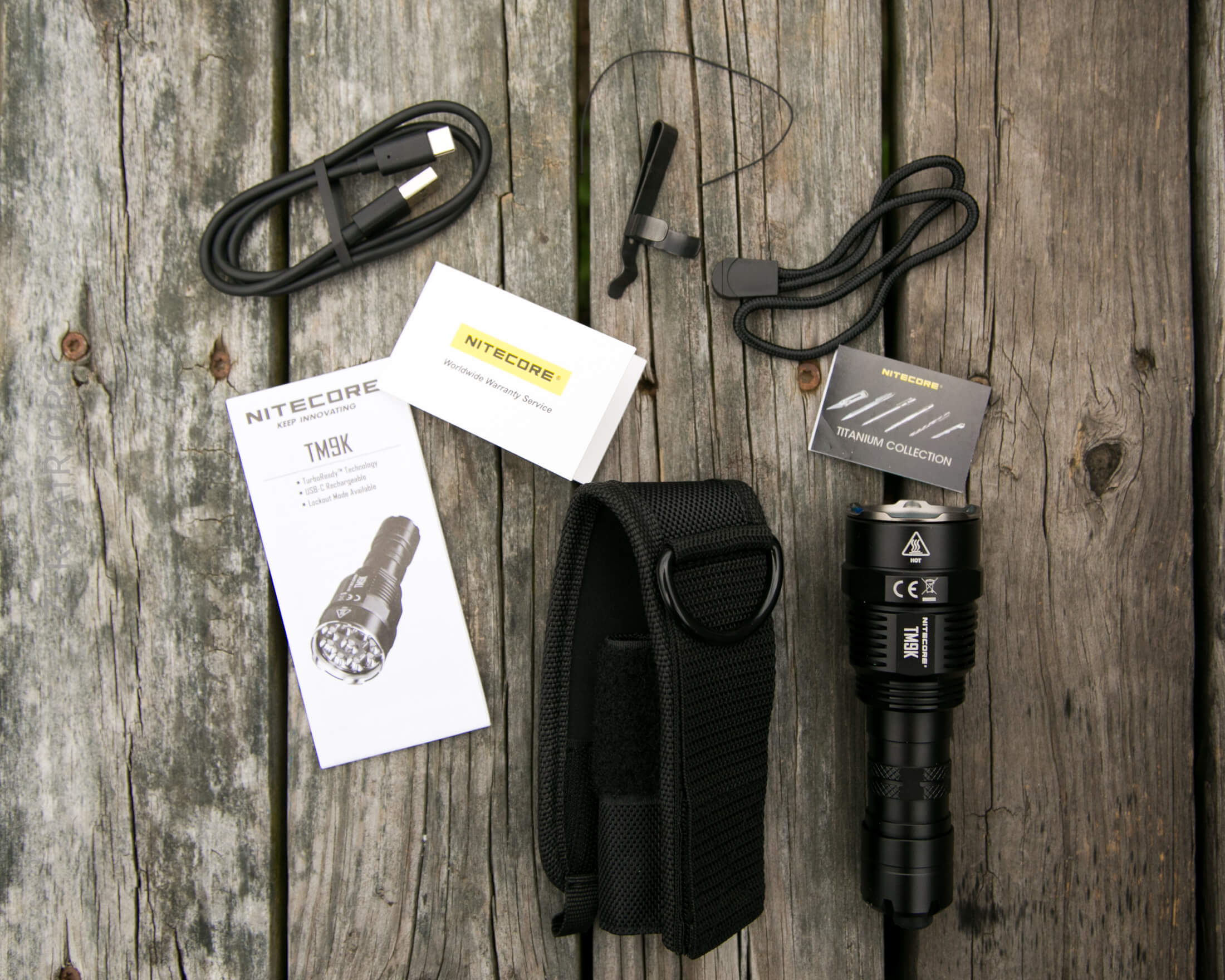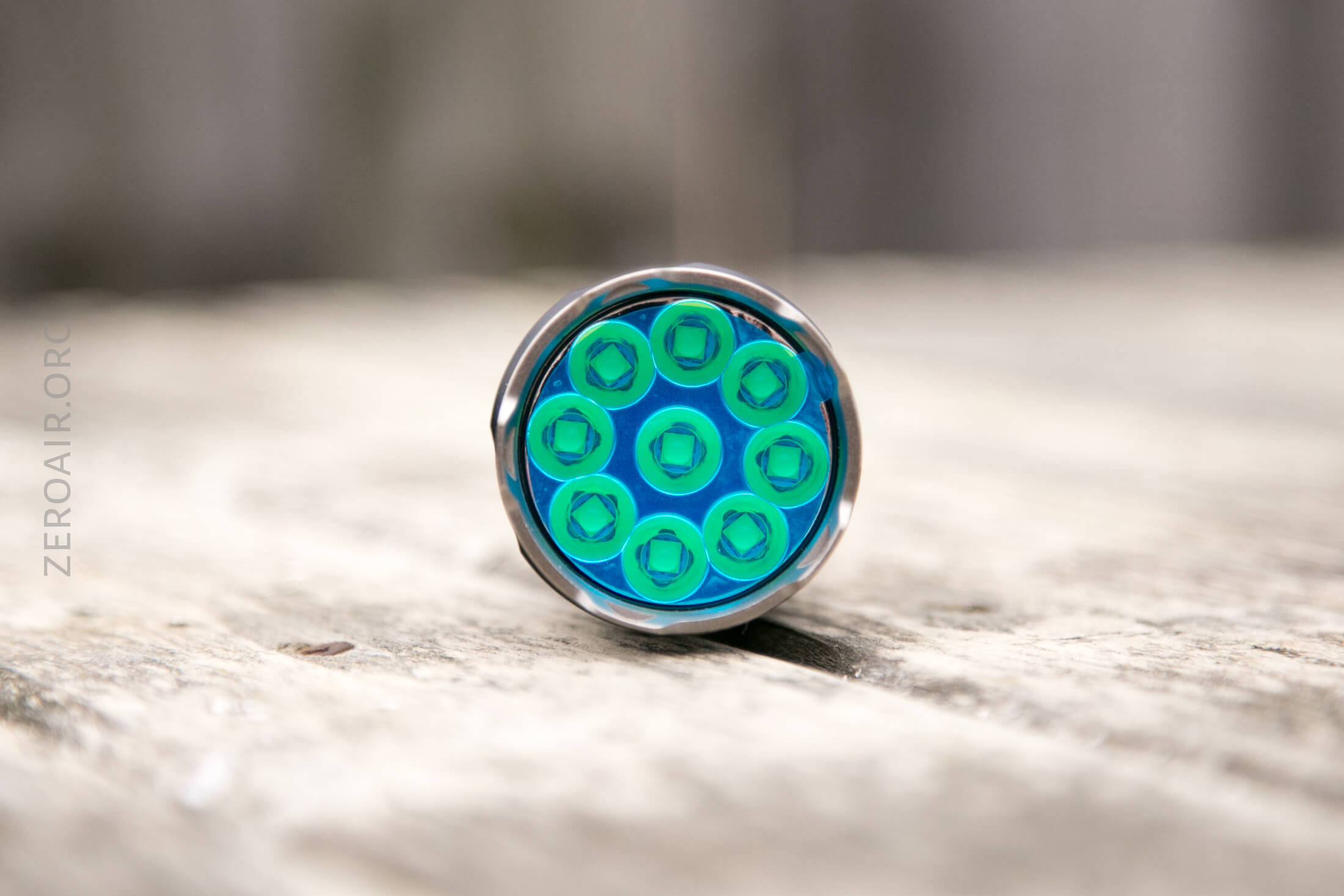Nitecore TM9K Flashlight Review
The Nitecore TM9K Flashlight boasts a brief 9500-lumen output, a built-in cell, and onboard USB-C charging. Read on for some testing!
Official Specs and Features
Here’s a link to the Nitecore TM9K Flashlight product page.
Versions
Just one
Price
This one goes for $159.95. Here’s a referral link to NitecoreStore.com.
Short Review
For brief, floody, high-output needs, this light is great. I don’t love that the cell is built-in, but it is what it is. The interface is good, too. I would like to see the price come down a good bit, though.
Long Review
The Big Table
| Nitecore TM9K Flashlight | |
|---|---|
| Emitter: | Cree XP-L HD (x9) |
| Price in USD at publication time: | $159.95 |
| Cell: | 1×21700 (built-in) |
| Turbo Runtime | High Runtime |
| LVP? | Switched to low (but almost certainly has LVP) |
| Switch Type: | Both |
| Quiescent Current (A): | – |
| On-Board Charging? | Yes |
| Chargetime (from USB, not USB-C) | |
| Power off Charge Port with no Cell? | – |
| Claimed Lumens (lm) | 9500 |
| Measured Lumens (at 30s) | 2375 (25% of claim)^ |
| Candela per Lumen | 1.8 |
| Claimed Throw (m) | 268 |
| Candela (Calculated) in cd (at 30s) | 148lux @ 5.738m = 4873cd |
| Throw (Calculated) (m) | 139.6 (52.1% of claim)^ |
| All my Nitecore reviews! | |
^ Measurement disclaimer: Testing flashlights is my hobby. I use hobbyist-level equipment for testing, including some I made myself. Try not to get buried in the details of manufacturer specifications versus measurements recorded here; A certain amount of difference (say, 10 or 15%) is perfectly reasonable. These are 30 second tests. Below is startup
| Nitecore TM9K | |
|---|---|
| Claimed Lumens (lm) | 9500 |
| Measured Lumens (at 30s) | 10057 (105.9% of claim)^ |
| Candela per Lumen | 1.8 |
| Claimed Throw (m) | 268 |
| Candela (Calculated) in cd (at 30s) | 1067lux @ 4.579m = 22372cd |
| Throw (Calculated) (m) | 299.1 (111.6% of claim)^ |
^ These measurements are startup measurements (not FL1).
What’s Included
- Nitecore TM9K flashlight
- Nylon pouch
- Lanyard (with helper)
- Pocket clip (friction fit)
- Charge cable (USB to USB-C)
- Manual etc
Package and Manual
Run the light with this little protector and you’ll discover what “angry blue” is. 🙂
Build Quality and Disassembly
This is a nice little chonk of a light. It has a very nice weight. Heavy, in the way that often means things are well made.
The head has cooling fins.
The body has some knurling but it’s entirely decorative.
The switch is very proud.
I didn’t disassemble this one. The cell inside is soldered, and my tailcap and other parts were all screwed down tightly enough (or possibly even thread locked) so that I couldn’t make them budge.
Size and Comps
Officially:
Length 125 mm / 4.92 in
Head Size 40 mm / 1.57 in
Weight 218 g / 7.68 oz
Wish I’d thought to put this beside a Convoy C8 or the like. It’s around that size.
Retention and Carry
Primary carry will likely be the nylon pouch, which is directional (bezel up). There’s also a nice metal D-ring – no plastic junk here! The pouch is open at the bottom, allowing access to the switches, but not open at the top.
Also included is a friction-fit pocket clip. It can technically go in two locations, but the only reasonable place is as seen below. The clip may be removed fairly easily, so while a lanyard could go on here, it’s not ideal. But generally as a belt clip, it’s pretty good.
The lanyard is very simple.
Despite the little hole in the tailcap looking like a lanyard loop hole, it’s not. So the only place to put the lanyard is on the pocket clip.
There’s a tiny helper which would make attaching the lanyard here easy enough.
Power and Runtime
I didn’t disassemble this light, so I didn’t see the cell. Here’s Nitecore’s rendering of the internal 21700:
Complain as you might about this cell being solidly fixed inside the light, it does provide quite the performance.
Below is a runtime on Turbo. Turbo isn’t allowed as a steady state, so I continually pressed the button over and over to see how heat responded and how the output fared. Surprisingly, quite well. In fact (and strangely) the output rises a little on successive repeats! The max I saw was 10057 lumens, which is approximately the claim made by Nitecore. But that’s not an FL1 rating. I also hit Turbo again at the 65ish minute mark, twice, and note that the light hits the high mark, but also steps down to the High output, and will stay there for a while, if the Turbo Ready button is continually depressed.
Thought I’d blow up that first few minutes (better than the 2 minute inset above), to display the output creeping up on successive turbo resets. Also see how the temperature creeps up, too. I do believe I reached a point after these 7 resets that the light no longer was hitting the 9K output.
Below is a test of high. The light does stepdown; most likely a temperature based stepdown.
The light also has a built-in power indicator. It looks to be only accessed when entering lockout, but that’s a fairly simple proposition. The indicator is beside the switches and lights blue only. When the lockout is entered, the indicator will blink out the voltage exactly. Four blinks with a 1.5s pause then one blink is a cell voltage of 4.1V. This also happens during runtimes – when the light reaches ~50% power, the indicator will blink every 2s. When the cell is “near to depletion” the indicator will blink continuously, and quickly.
Also included of course since there’s a built-in cell, is on-board charging. An appropriate cable is included – USB to USB-C.
The charge port is in the head, with a press in cover.
It’s an unusual cover because it fits into the charge port. It’s quite secure.
I tested with just the cable included, and not USB-C to USB-C. I don’t have a working tester for that setup now anyway (nor does it seem to be the way Nitecore intended to be charged). Charging is at around 1.3A, which is respectable, and takes around 4 hours to fully charge. You’ll note at the start of the charge, the current is low, around 0.2A. I imagine this to be a soft start on a depleted cell. So Nitecore’s charge circuit seems to take into account how depleted a cell is.
Modes and Currents
| Mode | Mode Claimed Output (lm) | Claimed Runtime | Measured Lumens | Tailcap Amps |
|---|---|---|---|---|
| Turbo | 9500 | – | 2735 | – |
| High | 1900 | 3h | 2350 | – |
| Mid | 460 | 4h30m | 531 | – |
| Low | 130 | 14h | 152 | – |
| Ultralow | 30 | 60h | 47 | – |
Pulse Width Modulation
The light exhibits PWM on the lower three modes, but I didn’t notice it during use.
For reference, here’s a baseline shot, with all the room lights off and almost nothing hitting the sensor. Also, here’s the light with the worst PWM I could find. I’m adding multiple timescales, so it’ll be easier to compare to the test light. Unfortunately, the PWM on this light is so bad that it doesn’t even work with my normal scale, which is 50 microseconds (50us). 10ms. 5ms. 2ms. 1ms. 0.5ms. 0.2ms. In a display faster than 0.2ms or so, the on/off cycle is more than one screen, so it’d just (very incorrectly) look like a flat line. I wrote more about this Ultrafire WF-602C flashlight and explained a little about PWM too.
User Interface and Operation
There are two switches on the TM9K. The Power button is the big proud mechanical switch. The mode button is a paddle (ish) switch that doesn’t rise over the edge of the tailcap at all.
Here’s a UI table!
| State | Action | Result |
|---|---|---|
| Off | Click Power Switch (PS) | On (last used mode) |
| Off | Half press PS | Momentary (last used mode) |
| On | Click PS | Off |
| On | Click Mode Switch (MS) | Mode advance (Ultralow>L>M>H) |
| Any | Hold MS | Turbo Ready Turbo |
| Any | Double click MS | Strobe |
| Strobe | Click MS | Previous Mode |
| Off | Click PS while holding MS | Lockout (with battery level indication) |
| Lockout | Triple click MS | Unlock |
LED and Beam
The TM9K has 9 Cree XP-L HD emitters and is basically a mule. Each of those has a tiny reflector, but really, this is a mule. Up close, the beam shape can be seen, but past about 3 feet it just becomes entirely flood.
Not that it’s bad. Mules are great and have good uses. I don’t think it’s stated anywhere, but these lean toward the CW temperature.
These beamshots are always with the following settings: f8, ISO100, 0.3s shutter, and manual 5000K exposure.
Tint vs BLF-348 (KillzoneFlashlights.com 219b version) (affiliate link)
I keep the test flashlight on the left, and the BLF-348 reference flashlight on the right.
I compare everything to the Killzone 219b BLF-348 because it’s inexpensive and has the best tint!
Conclusion
What I like
- Solid little chunk of a light
- Incredible (brief) output
- Able to USB-C charge (properly)
- 1.3A charging from regular USB isn’t bad at all anyway
What I don’t like
- Integrated cell, and not user-replaceable
- No good lanyard attachment point
Notes
- This light was provided by Nitecore for review. I was not paid to write this review.
- This content originally appeared at zeroair.org. Please visit there for the best experience!
- For flashlight-related patches, stickers, and gear, head over to PhotonPhreaks.com!
- Use my amazon.com referral link if you’re willing to help support making more reviews like this one!
- Please support me on Patreon! I deeply appreciate your support!

































































Pingback: Nitecore P20v2 Flashlight Review – ZeroAir Reviews